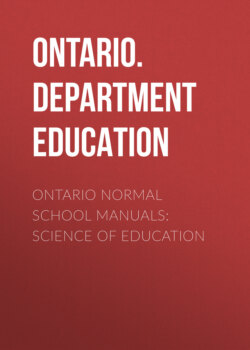Читать книгу Ontario Normal School Manuals: Science of Education - Ontario. Department of Education - Страница 50
На сайте Литреса книга снята с продажи.
KNOWLEDGE OF PROBLEM
ОглавлениеTable of Contents
Relation to Pupil's Knowledge.—Since the conscious apprehension of the problem by the pupil in its relation to his present knowledge constitutes the best motive for the learning process, a question arises how this problem is to be grasped by the pupil. First, it is evident that the problem is not a state of knowledge, or a complete experience. If such were the case, there would be nothing for him to learn. It is this partial ignorance that causes a problem to exist for the learner as a felt need, or motive. On the other hand it is not a state of complete ignorance, otherwise the learner could not call up any related ideas for its solution. When, for example, the child, after learning the various physical features, the climate, and people of Ontario, is presented with the problem of learning the chief industries, he is able by his former knowledge to realize the existence of these industries sufficiently to feel the need of a fuller realization. In the same way the student who has traced the events of Canadian History up to the year 1791, is able to know the Constitutional Act as a problem for study, that is, he is able to experience the existence of such a problem and to that extent is able to know it. His mental state is equally a state of ignorance, in that he has not realized in his own consciousness all the facts relative to the Act. In the orderly study of any school subject, therefore, the mastery of the previous lesson or lessons will in turn suggest problems for further lessons. It is this further development of new problems out of present knowledge that demands an orderly sequence of topics in the different school subjects, a fact that should be fully realized by the teacher.
Recognition of Problem: A. Prevents Digressions.—An adequate recognition of the lesson problem by the pupil in the light of his own experience is useful in preventing the introduction of irrelevant material into the lesson. Young children are particularly prone (and, under certain circumstances, older students also) to drag into the lessons interesting side issues that have been suggested by some phase of the work. As a rule, it is advisable to follow closely the straight and narrow road that leads to the goal of the lesson and not to permit digressions into attractive by-paths. If a pupil attempts to introduce irrelevant matter, he should be asked what the problem of the lesson is and whether what he is speaking of will be of any value in attaining that end. The necessity of this will, however, be seen more fully in our consideration of the next division of the learning process.
B. Organizes the Lesson Facts.—The adequate recognition of the lesson problem is valuable in helping the pupil to organize his knowledge. If you take a friend for a walk along the streets of a strange city engaging him in interesting conversation by the way, and if, when you have reached a distant point, you tell him that he must find his way back alone, he will probably be unable to do so without assistance. But if you tell him at the outset what you are going to do, he will note carefully the streets traversed, the corners turned, the directions taken, and will likely find his way back easily. This is because he had a clearly defined problem before him. The conditions are much the same in a lesson. When the pupil starts out with no definite problem and is led along blindly to some unknown goal, he will be unable to retrace his route; that is, he will be unable to reproduce the matter over which he has been taken. But with a clearly defined problem he will be able to note the order of the steps of the lesson, their relation to one another and to the problem, and when the lesson is over he will be able to go over the same course again. The facts of the lesson will have become organized in his mind.
